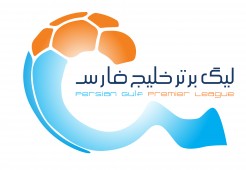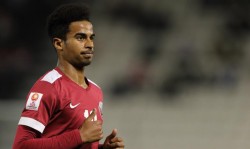-
 Ahdaaf 2018 Predictions
1 month ago
Ahdaaf 2018 Predictions
1 month ago -
 Ali Kadhim: The Iraqi goalscoring legend
1 week ago
Ali Kadhim: The Iraqi goalscoring legend
1 week ago -
 Reds in the Sand: Three Liverpool Men Who Played in UAE
4 weeks ago
Reds in the Sand: Three Liverpool Men Who Played in UAE
4 weeks ago -
 Qatar Aspires to Global Dominance through European Network
4 weeks ago
Qatar Aspires to Global Dominance through European Network
4 weeks ago
LEGENDS OF ARABIA: A HISTORY OF FOREIGNERS IN QATAR, PART 1
Last month saw the unveiling of Xavi Hernandez, amidst much fanfare, as an Al-Sadd player. The Barcelona legend may have attracted a lot of media attention with his decision to move to Qatar, but he is far from the first big name to do it. Lots of foreign stars have chosen to play in Qatar over the years – some of them were already household names, while many others became stars in their own right after their move to the emirate.
The history of foreign players in Qatar is filled with great tales of legendary exploits. Although the first two decades of the Qatari League mainly featured players from the Middle East and Africa, the 1990s and 2000s saw the beginning of a new chapter in the story of Qatari football. Highly skilled players from afar were brought in – not just to win titles, but also to lift the standard of the game and bring fans to the stadiums.
The beginning
In the beginning, things were pretty much low-key. In the early years of the Qatari League, after its founding in 1973, foreign players rarely arrived from abroad à la Xavi. With most of the imported players coming from the neighbouring countries and from East Africa, the Qatari League’s foreign contingent had very little non-Arabic flavour. All that changed in the 1980s.
An interesting story from this period is that of Abedi ‘Pele’ Ayew, one of Africa’s first true footballing superstars. Before he became famous on the Old Continent, he kicked a ball about for Real Tamale United in his native Ghana. After starring for the Ghana team thathatt won the 1982 African Cup of Nations, 17 year old Abedi made a surprise move – to Qatar. Al-Sadd, then a club aged just thirteen years old, had brought a star in the making to the Gulf, reportedly for a sum of $1000. Little did anyone know that this was no ordinary star. Abedi didn’t stay for long with Al Sadd, moving on to Zurich and taking tiny steps to stardom. Ten years later, he would be adjudged the Man of the Match in his side Marseille’s win over Milan in the UEFA Champions League final. However, despite all that he achieved, his first professional outing outside Ghana will always be his stint at Al-Sadd. This was something Abedi himself talked about during an audience with the Emir of Qatar, Sheikh Tamim bin Hamad al Thani (who is incidentally a former President of Al Sadd!) last year.
The Iranians
But I digress. Talk of foreign footballers in Qatar cannot really begin without mention of the Iranian pioneers who were among the first foreigners to make their mark on Qatari pitches. In 1981, ‘The Persian Black Pearl’ Abdolreza Barzegari became the first Iranian professional to play in the Qatari league when he joined Qatar SC (disputed by some accounts which say it was Al-Arabi). He was soon followed by many of his countrymen who crossed the Gulf, in search of a new adventure and probably for better pay as well. A report in the Qatari newspaper ‘Al Watan’ claims that much of the exodus of Iranians from the Iranian league was due to an issue with the Iranian FA. At least 14 players had excused themselves from representing the national team and the FA retaliated by banning them from playing in Iran. And thus many took the chance to try their luck in a foreign league – moving to either UAE or Qatar.
Regardless of whether this story is true or not, arguably the most prominent Iranian playing in the Arab side of the Gulf at that time was Barzegari’s friend Ebrahim Ghasempour. Ghasempour was an Asian Cup winner and a World Cupper and was one of the biggest names in the Qatari League back then. He had the rare opportunity of representing the big three of Qatari football – Al Arabi, Al Sadd and Al Rayyan. During his time at Al-Sadd, he won the Qatari League and the Champions League double in 1989, although he did not feature in the final of the latter against Al-Rasheed of Iraq, reportedly due to the Iran-Iraq War. Ghasempour remains popular in the minds of fans who remember the Qatari football scene of the 80s and was recently interviewed by Al Kass in a series about the Emir Cups of yesteryear.
Hamid Derakhshan, who was a star midfielder at Persepolis and also managed the Tehran giants until recently, was another notable Iranian who played in Qatar, appearing for Qatar SC and Al Sadd during a five year stay in the country. Another Persepolis legend Farhad Pious wrote his name into the history books during his solitary season in Qatar, when he ended the 1988-89 season as the top scorer of the League, scoring 9 goals for Al Ahli. It is a bit baffling to know that nine goals got him the award, considering that iconic Qatari striker Mansour Muftah used to win it with a tally of twenty. Nevertheless, the achievement was historic as Pious was the first foreign player to win the accolade.
The era of the marksman
After Pious broke the ice, the era of foreigners winning the Top Scorer Award (now named after Mansour Muftah) began in full flow in the 1990s. In the 26 seasons since Pious’ landmark achievement, 19 have seen foreign players come out on top. Quite intriguingly, Pious remains the only Iranian to have done so. Legendary striker Ali Daei came close in 1996/97 while playing for Al Sadd but missed out to Al Arabi’s Mubarak Mustafa by the margin of a single goal. Daei left for Germany and Iran soon became forgotten in the search for goalscorers.

Nigerian striker Ricky Owubokiri enjoyed a successful season at Al-Arabi in 1995-96, winning the league and finishing as the top scorer
The new marksmen coming in to Qatar now came from all over the world. From Brazilian Marco Antonio and Iraqi star Ahmed Radhi to Nigeria’s Richard ‘Ricky’ Owubokiri and Moroccan Hussein Amouta. Midfielder Amouta came up with a special effort in 1997/98 with 10 goals for Al Sadd that gave him the Top Scorer Award. He also went on to win the League in 2000. 13 years later, Amouta would go on to repeat the feat as manager of Al Sadd, thus garnering a remarkable double.
The legend of Akwa
The 1998/99 season saw the rise of Fabrice Akwa, a little-known Angolan who was making his debut for Al Wakrah. He had struggled to find his feet in the Portuguese league, playing for three clubs in four years before making the move to the Gulf. It proved to be the right move as Akwa powered the Blue Wave to a league and cup double, ending up as the top scorer in both. One of the highlights of his performances that season was a stunning overhead kick that he executed to perfection against Gharafa in the Heir Apparent Cup final. He had outrun Gharafa’s Yousuf Adam, but judging the flight of the ball, he moved back, jumped up and finished with panache past the hapless keeper Amer al-Kaabi.
Al-Wakrah had become the first club from outside Doha to win the league and they had Akwa to thank for it. No longer was he an unknown debutant; he was now hot property. Among the clubs now fighting for his signature were Saudi giants Al Shabab and Al Nassr, along with Egypt’s Al Zamalek. However, he opted to stay in Qatar itself when he jumped ship to Al Gharafa, who ensured they got the man who killed their title hopes.

Goal machine Fabrice Akwa, seen here with Argentine star Claudio Caniggia, during their time at Qatar SC
Akwa’s time at Al Gharafa was relatively less successful; so was his brutally short spell at Al-Sadd, which followed. His first and only match at Al-Sadd was an eventful one. Akwa showed great acrobatic skill to score what he thought was the equalizer against Al-Hilal in the 2001 Asian Cup Winners Cup semi-final, only to be ruled offside. (Video of disallowed goal: https://www.youtube.com/watch?v=6kYJF-PLG1A) Al-Sadd went on to lose the match and Akwa was suspended by the AFC for six months for confronting the linesman. He later moved to Qatar SC, where he returned to his old goalscoring form, scoring 32 goals over two seasons and adding a third Heir Apparent Cup title to his collection.
Akwa still had time for one last stint at Wakrah, which ended in acrimony after he abandoned the team mid-way through the season. Al-Wakrah were furious after he failed to return, threatening to take the case to FIFA. It was a blip in what was otherwise a successful stay in the country.
Regardless of the way his career in the country ended, the former captain and all-time top scorer of the Angolan national team remains to this day one of the best foreign players to ever kick a ball about in Qatar.
Click here to read Part 2 of this series
- The Gulf crisis, Fossati’s resignation and the naturalisation conundrum - June 14, 2017
- Ahdaaf Anniversary Special: AhdaafMAG Issue 1 - February 11, 2017
- 2018 World Cup Qualifying: South Korea v Qatar Q&A - October 5, 2016
- 2016/17 QATAR STARS LEAGUE PREVIEW - September 24, 2016
- FRIDAY WITH… SUPER FAN VIJAY BHARADWAJ - August 5, 2016
- QATAR STARS LEAGUE 2015/16 – SEASON PREVIEW - September 10, 2015
- PREVIEW: Al-Hilal vs. Lekhwiya | Asian Champions League 2015 - August 24, 2015
- LEGENDS OF ARABIA: A HISTORY OF FOREIGNERS IN QATAR, PART 3 - July 20, 2015
- LEGENDS OF ARABIA: A HISTORY OF FOREIGNERS IN QATAR, PART 2 - July 15, 2015
- LEGENDS OF ARABIA: A HISTORY OF FOREIGNERS IN QATAR, PART 1 - July 13, 2015
Similar posts
-
 CountriesInternationalsRegional Competitions
CountriesInternationalsRegional Competitions
The Gulf crisis, Fossati’s resignation and the naturalisation conundrum
-
 Internationals
Internationals
WCQ2018 Asia: 6 Talking Points from the Middle East
-
 Internationals
Internationals
PRESS TALK: August 31, 2016
-
 AFC Champions League
AFC Champions League
PREVIEW: EL-JAISH VS. AL-NASR | #ACL2016
-
 Persian Gulf Pro League
Persian Gulf Pro League
Persian Gulf Pro League Preview: 2016/17 Season
-
 Scout Reports
Scout Reports
SCOUT REPORT: Akram Afif
-
Nuremburg
-
Ahmed
-









